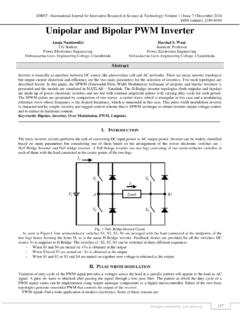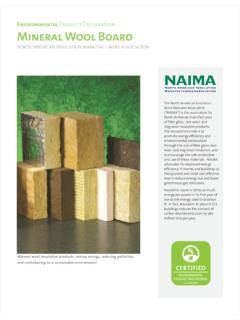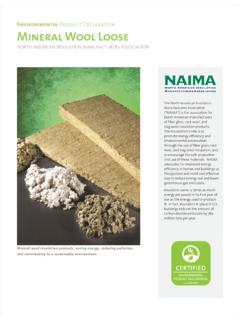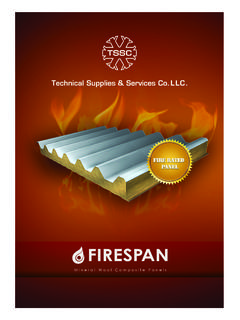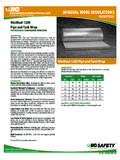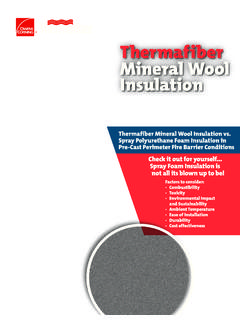Transcription of A Review on Thermal Insulation and Its Optimum Thickness ...
1 IJIRST International Journal for Innovative Research in Science & Technology| Volume 2 | Issue 06 | November 2015 ISSN (online): 2349-6010 All rights reserved by 1 A Review on Thermal Insulation and Its Optimum Thickness to Reduce Heat Loss Dinesh Kumar Sahu Prakash Kumar Sen Student Lecturer Department of Mechanical Engineering Department of Mechanical Engineering Kirodimal Institute of Technology, Raigarh ( ) Kirodimal Institute of Technology, Raigarh ( ) Gopal Sahu Ritesh Sharma Lecturer Lecturer Department of Mechanical Engineering Department of Mechanical Engineering Kirodimal Institute of Technology, Raigarh ( ) Kirodimal Institute of Technology, Raigarh ( )
2 Shailendra Bohidar Lecturer Department of Mechanical Engineering Kirodimal Institute of Technology, Raigarh ( ) Abstract An understanding of the mechanisms of heat transfer is becoming increasingly important in today s world. Conduction and convection heat transfer phenomena are found throughout virtually all of the physical world and the industrial domain. A Thermal insulator is a poor conductor of heat and has a low Thermal conductivity. In this paper we studied that Insulation is used in buildings and in manufacturing processes to prevent heat loss or heat gain.
3 Although its primary purpose is an economic one, it also provides more accurate control of process temperatures and protection of personnel. It prevents condensation on cold surfaces and the resulting corrosion. We also studied that critical radius of Insulation is a radius at which the heat loss is maximum and above this radius the heat loss reduces with increase in radius. We also gave the concept of selection of economical Insulation material and Optimum Thickness of Insulation that give minimum total cost. Keywords: Heat, Conduction, Convection, Heat Loss, Insulation _____ I.
4 INTRODUCTION Heat flow is an inevitable consequence of contact between objects of differing temperature. Thermal Insulation provides a region for Insulation in which Thermal conduction is reduced or Thermal radiation is reflected rather than absorbed by the lower temperature body. To change the temperature of an object, energy is required in the form of heat generation to increase the temperature, or heat extraction to reduce the temperature. Once the heat generation or heat extraction is terminated a reverse flow of heat occurs to reverse the temperature back to ambient.
5 To maintain a given temperature considerable continuous energy is required. Insulation will reduce this energy loss. Heat may be transferred in three mechanisms: conduction, convection and radiation. Thermal conduction is the molecular transport of heat under the effect of temperature gradient. Convection mechanism of heat occurs in liquids and gases, whereby the flow processes transfer heat. Free convection is flow caused by the differences in density as a result of temperature differences. Forced convection is flow caused by external influences (wind, ventilators, etc.)
6 Thermal radiation mechanism occurs when Thermal energy is emitted similar to light radiation. Heat transfers through Insulation material occur by means of conduction, while heat loss to or heat gain from atmosphere occurs by means of convection and radiation. Materials, which have a low Thermal conductivity, are those, which have a high proportion of small voids containing air or gases. These voids are not big enough to transmit heat by convection or radiation, and therefore reduce the flow of heat. Thermal Insulation materials come into the latter category.
7 Thermal Insulation materials may be natural substances or man-made. II. THE NEED FOR Insulation A Thermal insulator is a poor conductor of heat and has a low Thermal conductivity. Insulationis used in buildings and in manufacturing processes to prevent heat loss or heat gain. Although its primary purpose is an economic one, it also provides more accurate control of process temperatures and protection of personnel. It prevents condensation on cold surfaces and the resulting corrosion. Such materials are porous, containing large number of dormant air cells.
8 Thermal Insulation delivers the following benefits: [1][2] A Review on Thermal Insulation and Its Optimum Thickness to Reduce Heat Loss (IJIRST/ Volume 2 / Issue 06/ 001) All rights reserved by 2 Energy Conservation energy by reducing the rate of heat flow (fig 1) is the primary reason for insulating surfaces. Insulation materials that will perform satisfactorily in the temperature range of -268 C to 1000 C are widely available. Fig. 1: Thermal Insulation retards heat transfer by acting as a barrier in the path of heat flow Personnel Protection and Comfort surface that is too hot poses a danger to people who are working in that area of accidentally touching the hot surface and burning themselves.
9 To prevent this dangerand to comply with the OSHA (Occupational Safety and HealthAdministration) standards, the temperatures of hot surfaces should be reduced to below 60 C (140 F) by insulating them. Maintaining Process Temperature processes in the chemical industry are temperature-sensitive, and it may become necessary to insulate the process tanks and flow sections heavily to maintain the same temperature throughout. Reducing Temperature Variation and Fluctuations temperature in an enclosure may vary greatly between the midsection and the edges if the enclosure is not insulated.
10 Insulation minimizes temperature non-uniformity in an enclosure and slows down fluctuations. Condensation and Corrosion Prevention vapor in the air condenses on surfaces whose temperature is below the dew point, and the outer surfaces of the tanks or pipes that contain a cold fluid frequently fall below the dew-point temperature unless they have adequate Insulation . The liquid water on exposed surfaces of the metal tanks or pipes may promote corrosion as well as algae growth. Fire Protection during a fire may be minimized by keeping valuable combustibles in a safety box that is well insulated.



